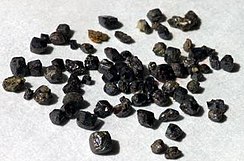
Back تيتانات السترونتيوم Arabic تیتانات استرانسیوم AZB Triòxid d'estronci i titani Catalan Strontiumtitanat German Titanato de estroncio Spanish تیتانیت استرانسیم Persian Strontiumtitanaatti Finnish Titanate de strontium French סטרונציום טיטנאט HE Titanato di stronzio Italian

| |
| Names | |
|---|---|
| Other names
Strontium titanium oxide
Tausonite STO | |
| Identifiers | |
3D model (JSmol)
|
|
| ChemSpider | |
| ECHA InfoCard | 100.031.846 |
| EC Number |
|
| MeSH | Strontium+titanium+oxide |
PubChem CID
|
|
| UNII | |
CompTox Dashboard (EPA)
|
|
| |
| |
| Properties | |
| SrTiO 3 | |
| Molar mass | 183.49 g/mol |
| Appearance | White, opaque crystals |
| Density | 5.11 g/cm3 |
| Melting point | 2,080 °C (3,780 °F; 2,350 K) |
| insoluble | |
Refractive index (nD)
|
2.394 |
| Structure | |
| Cubic Perovskite | |
| Pm3m, No. 221 | |
Except where otherwise noted, data are given for materials in their standard state (at 25 °C [77 °F], 100 kPa).
| |
Strontium titanate is an oxide of strontium and titanium with the chemical formula SrTiO3. At room temperature, it is a centrosymmetric paraelectric material with a perovskite structure. At low temperatures it approaches a ferroelectric phase transition with a very large dielectric constant ~104 but remains paraelectric down to the lowest temperatures measured as a result of quantum fluctuations, making it a quantum paraelectric.[1] It was long thought to be a wholly artificial material, until 1982 when its natural counterpart—discovered in Siberia and named tausonite—was recognised by the IMA. Tausonite remains an extremely rare mineral in nature, occurring as very tiny crystals. Its most important application has been in its synthesized form wherein it is occasionally encountered as a diamond simulant, in precision optics, in varistors, and in advanced ceramics.
The name tausonite was given in honour of Lev Vladimirovich Tauson (1917–1989), a Russian geochemist. Disused trade names for the synthetic product include strontium mesotitanate, Diagem, and Marvelite. This product is currently being marketed for its use in jewelry under the name Fabulite.[2] Other than its type locality of the Murun Massif in the Sakha Republic, natural tausonite is also found in Cerro Sarambi, Concepción department, Paraguay; and along the Kotaki River of Honshū, Japan.[3][4]
- ^ K. A. Muller; H. Burkard (1979). "SrTiO3: An intrinsic quantum paraelectric below 4 K". Phys. Rev. B. 19 (7): 3593–3602. Bibcode:1979PhRvB..19.3593M. doi:10.1103/PhysRevB.19.3593.
- ^ Mottana, Annibale (March 1986). "Una brillante sintesi". Scienza e Dossier (in Italian). 1 (1). Giunti: 9.
- ^ "Tausonite". Webmineral. Retrieved 2009-06-06.
- ^ "Tausonite". Mindat. Retrieved 2009-06-06.
© MMXXIII Rich X Search. We shall prevail. All rights reserved. Rich X Search